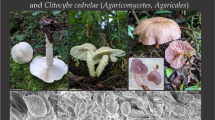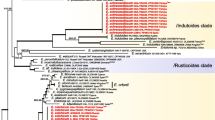Abstract
Sebacinoid fungi show a broad mycorrhizal capacity; therefore, they play a very important role in natural systems. Worldwide, fungi of Sebacinales are present under different environmental conditions and associate with diverse plant hosts, however, are hitherto poorly studied in China. Two sebacinoid ectomycorrhizae (ECM), Pinirhiza multifurcata and Pinirhiza nondextrinoidea, are described in detail morphologically and anatomically in the present study. They share a plectenchymatous outer mantle with multiply ramified hyphae in a gelatinous matrix, clampless, thin, thick-walled emanating hyphae with mostly Y-shaped ramifications and triangular inflations at the point of ramification. P. multifurcata and P. nondextrinoidea can be distinguished by thick cells in mantle layers, the ramification of emanating hyphae, the presence or absence of rhizomorphs, as well as the differing color reaction in Melzer's reagent. The putative molecular phylogenetic relationships of P. multifurcata and P. nondextrinoidea were inferred by analyses of the partial large subunit nuclear rDNA (nLSU); however, an affiliation to fungal species was not possible. This is the first report of sebacinoid ECM on Chinese pine.






Similar content being viewed by others
References
Agerer R (1987–2008) Colour atlas of ectomycorrhizae, 1st–14th delivery. Einhorn, Schwäbisch Gmünd
Agerer R (1991) Characterization of ectomycorrhizae. In: Norris JR, Read DJ, Varma AK (eds) Techniques for the study of mycorrhiza. Methods in microbiology, vol 23. Acad Press, London et al, pp 25–73
Agerer R (2006) Fungal relationships and structural identity of their ectomycorrhizae. Mycol Progress 5:67–107
Agerer R, Rambold G (2004–2009, First posted on 2004-06-01; most recent update: 2009-01-26) DEEMY—an information system for characterization and determination of ectomycorrhizae. www.deemy.de München, Germany
Águeda B, Agerer R, De Miguel AM, Parladé J (2008) “Quercirhiza quadratum” + Quercus ilex L. subsp.ballota (Scop.) Desf. Samp. Descr Ectomyc 11/12:113–123
Avis PG, McLaughlin DJ, Dentinger BC, Reich PB (2003) Long-term increase in nitrogen supply alters above and below-ground ectomycorrhizal communities and increases the dominance of Russula spp. in a temperate oak savanna. New Phytol 160:239–253
Azul AM, Agerer R, Freitas H (2006) “Quercirhiza dendrohyphidiomorpha” + Quercus suber L. Descr Ectomyc 9/10:87–91
Bidartondo M, Burghardt B, Gebauer G, Bruns TD, Read DJ (2004) Changing partners in the dark:isotopic and molecualr evidence of ectomycorrhizal liaisons between forest orchids and trees. Proc R Soc Lond B 271:1799–1806
Blackwell M, Hibbett D, Taylor JW, Spatafora JW (2006) Research coordination networks: a phylogeny for kingdom Fungi (Deep Hypha). Mycologia 98(6):829–837
Gardes M, Bruns TD (1993) ITS primers with enhanced specificity for basidiomycetes -applications to the identification of mycorrhizae and rusts. Mol Ecol 2:113–118
Glen M, Tommerup IC, Bougher NL, O’Brien PA (2002) Are Sebacinaceae common and widespread ectomycorrhizal associates of Eucalyptus species in Australian forests? Mycorrhiza 12:243–247
Gronbach E, Agerer R (1986) Charakterisierung und Inventur der fichten-mykorrhizen im höglwald und deren reaktion auf saure beregnung. Forstwiss Cbl 105:329–335
Hall T (2005) BioEdit, biological sequence alignment editor for Win95/98/NT/2K/XP. Carlsbad, California: Ibis therapeutic
Julou T, Burghardt B, Gebauer G, Berveiller D, Damesin C, Selosse MA (2005) Mixotrophy in orchids: insights from a comparative study of green individuals and nonphotosynthetic individuals of Cephalanthera damasonium. New Phytol 166:639–653
Kõljalg U, Larsson KH, Abarenkov K, Nilsson RH, Alexander IJ, Eberhardt U, Erland S, Hoiland K, Kjoller R, Larsson E, Pennanen T, Sen R, Taylor AFS, Tedersoo L, Vralstad T, Ursing BM (2005) UNITE: a database providing web-based methods for the molecular identification of ectomycorrhizal fungi. New Phytol 166:1063–1068
Kottke I, Beiter A, Weiß M, Haug I, Oberwinkler F, Nebel M (2003) Heterobasidiomycetes form symbiotic associations with hepatics: Jungermanniales have sebacinoid mycobionts while Aneura pinguis (Metzgeriales) is associated with a Tulasnella species. Mycol Res 107:957–968
Moncalvo JM, Lutzoni FM, Rehner SA, Johnson J, Vilgalys R (2000) Phylogenetic relationships of agaric fungi based on nuclear large subunit ribosomal DNA sequences. Syst Biol 49:278–305
Obase K, Cha JY, Lee JK, Lee SY, Lee JH, Chun KW (2009) Ectomycorrhizal fungal communities associated with Pinus thunbergii in the eastern coastal pine forests of Korea. Mycorrhiza 20:39–49
Richard F, Millot S, Gardes M, Selosse MA (2005) Diversity and specificity of ectomycorrhizal fungi retrieved from an old-growth Mediterranean forest dominated by Quercus ilex. New Phytol 166:1011–1023
Selosse MA, Bauer R, Moyersoen B (2002a) Basal hymenomycetes belonging to the Sebacinaceae are ectomycorrhizal on temperate deciduous trees. New Phytol 155:183–195
Selosse MA, Weiß M, Jany JL, Tillier A (2002b) Communities and populations of sebacinoid basidiomycetes associated with the achlorophyllous orchid Neottia nidus-avis (L.) L.C.M. Rich. and neighbouring tree ectomycorrhizae. Mol Ecol 11:1831–1844
Selosse MA, Faccio A, Scappaticci G, Bonfante P (2004) Chlorophyllous and achlorophyllous specimens of Epipactis microphylla (Neottieae, Orchidaceae) are associated with ectomycorrhizal septomycetes, including truffles. Micro Ecol 47:416–426
Selosse MA, Setaro S, Glatard F, Rhichard F, Urcelay C, Weiß M (2007) Sebacinales are common mycorrhizal associates of Ericaceae. New Phytol 174(4):864–878
Selosse MA, Dubois MP, Alvarez N (2009) Do Sebacinales commonly associate with plant roots as endophytes? Mycol Res 113:1062–1069
Setaro S, Weiß M, Oberwinkler F, Kottke I (2006) Sebacinales form ectendomycorrhizas with Cavendishia nobilis, a member of the Andean clade of Ericaceae, in the mountain rain forest of southern Ecuador. New Phytol 169:355–365
Sikes DS, Lewis PO (2001) PAUPRat: A tool to implement Parsimony Ratchet searches using PAUP*. (http://viceroy.eeb.uconn.edu/paupratweb/pauprat.htm)
Smith ME, Douhan GW, Rizzo DM (2007) Ectomycorrhizal community structure in a xeric Quercus woodland based on rDNA sequence analysis of sporocarps and pooled roots. New Phytol 174:847–863
Stamatakis A (2006) RAxML-VI-HPC: maximum likelihood-based phylogenetic analyses with thousands of taxa and mixed models. Bioinformatics 22:2688–2690
Stamatakis A, Hoover P, Rougement J (2008) A rapid bootstrap algorithm for the RAxML web-servers. Syst Biol 75:758–771
Swofford DL (2003) PAUP*. Phylogenetic analysis using parsimony (* and other methods). Version 4. Sinauer Associates, Sunderland, Massachusetts
Taylor DL, Bruns TD, Szaro TM, Hodges SA (2003) Divergence in mycorrhizal specialization within Hexalectris spicata (Orchidaceae), a nonphotosynthetic desert orchid. Am J Bot 90:1168–1179
Tedersoo L, Suvi T, Larsson E, Kõljalg U (2006) Diversity and community structure of ectomycorrhizal fungi in a wooded meadow. Mycol Res 110:734–748
Thiers B (2009, continuously updated) Index Herbariorum: A global directory of public herbaria and associated staff. New York Botanical Garden's Virtual Herbarium. sciweb.nybg.org/science2/IndexHerbariorum.asp.
Urban A, Weiss M, Bauer R (2003) Ectomycorrhizas involving sebacinoid mycobionts. Mycol Res 107(1):3–14
Urban A, Puschenreiter M, Strauss J, Gorfer M (2008) Diversity and structure of ectomycorrhizal and co-associated fungal communities in a serpentine soil. Mycorrhiza 18:339–354
Wei J, Peršoh D, Agerer R (2009) Four Ectomycorrhizae of pyronemataceae (pezizomycetes) on Chinese Pine (Pinus tabulaeformis)—morpho-anatomical and molecular–phylogenetic analyses. Mycological Progress (in Press)
Weiß M, Oberwinkler F (2001) Phylogenetic relationships in Auriculariales and related groups—hypotheses derived from nuclear ribosomal DNA sequences. Mycol Res 105:403–415
Weiß M, Selosse MA, Rexer KH, Urban A, Oberwinkler F (2004) Sebacinales: a hitherto overlooked cosm of heterobasidiomycetes with a broad mycorrhizal potential. Mycol Res 108(9):1003–1010
White TJ, Bruns TD, Lee SB, Taylor JW (1990) Analysis of phylogenetic relationships by amplification and direct sequencing of ribosomal RNA genes. In: Innis MA, Gelfand DH, Sninsky JN, White TJ (eds) PCR Protocols: a guide to method and applications. Academic Press, San Diego, pp 315–322
Zhang Z, Schwartz S, Wagner L, Miller W (2000) A greedy algorithm for aligning DNA sequences. J Comput Biol 7:203–214
Acknowledgments
This study was financially supported by the German Academic Exchange Service (DAAD). We thank also Prof. Yan Wei (Inner Mongolia Agricultural University, Huhhot, Inner Mongolia, China) for his support regarding field work and equipment, Fan Yongjun (Inner Mongolia Agricultural University, Huhhot, Inner Mongolia, China) for his field assistance, Derek Peršoh (University of Munich) for his useful suggestions on phylogenetic analyses, Philomena Bodensteiner for her help on improving writing, and the Management Authority of Helan Mountain National Reserve and Heilihe National Reserve for the allowance of field sampling. We thank two anonymous reviewers, whose suggestions significantly improved the manuscript.
Author information
Authors and Affiliations
Corresponding author
Electronic supplementary material
Below is the link to the electronic supplementary material.
Fig. 7
Molecular phylogenetic placement of P. multifurcata and P. nondextrinoidea among selected Sebacinales inferred by the PAUPRat analysis of nLSU sequences. Posterior probability of nodes is 1.0, except where indicated otherwise. GenBank accession numbers are given in parentheses following the species names. (PPT 59 kb)
Rights and permissions
About this article
Cite this article
Wei, J., Agerer, R. Two sebacinoid ectomycorrhizae on Chinese pine. Mycorrhiza 21, 105–115 (2011). https://doi.org/10.1007/s00572-010-0312-8
Received:
Accepted:
Published:
Issue Date:
DOI: https://doi.org/10.1007/s00572-010-0312-8




